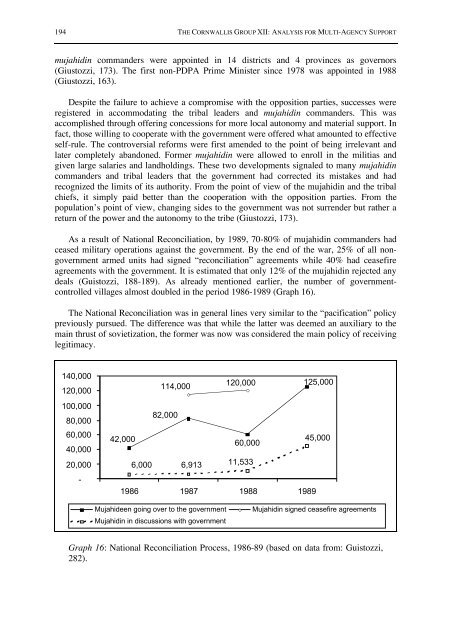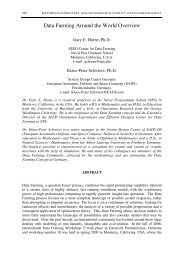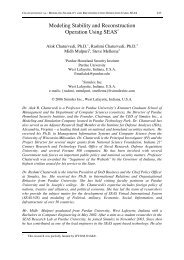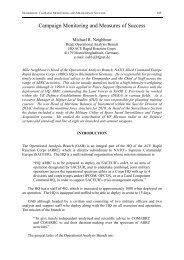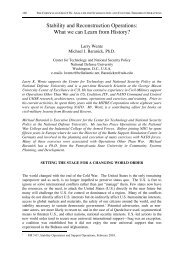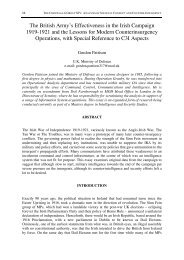MINKOV AND SMOLYNEC: 3-D SOVIET STYLE 193An <strong>in</strong>novative way to establish contact with <strong>the</strong> population outside regime’s control andto <strong>in</strong>crease government’s visibility was <strong>the</strong> establishment of special propaganda units – calledAgitprop. These units were jo<strong>in</strong>t Afghan – <strong>Soviet</strong> detachments and <strong>in</strong>cluded both civil andmilitary personnel. In addition to primarily <strong>Soviet</strong> soldiers, Agitprop was composed ofdoctors and nurses, enterta<strong>in</strong>ers and political activists, <strong>the</strong> latter mostly Afghans. Initiated bysome <strong>Soviet</strong> advisers <strong>in</strong> 1981 as a pilot project, <strong>the</strong> military brass <strong>in</strong>itially opposed <strong>the</strong>utilization of Agitprop, but after demonstrat<strong>in</strong>g positive results, <strong>in</strong> 1982, it was officiallyconstituted as part of <strong>the</strong> force structure (Giustozzi, 42). Agitprop units toured villages andspread <strong>in</strong>formation about <strong>the</strong> work of <strong>the</strong> government, distributed declarations of <strong>the</strong> LoyaJirgah, organized meet<strong>in</strong>gs, and concerts, and even projected movies <strong>in</strong> makeshift <strong>the</strong>aters(Giustozzi, 41). To w<strong>in</strong> over <strong>the</strong> villagers, Agitprop provided medical help and distributedfree fuel, medic<strong>in</strong>e and food. In <strong>the</strong> period 1981-89, Agitprop units provided medicalassistance to 400,000 people and distributed food and o<strong>the</strong>r supplies to 1,000,000 (Giustozzi,44). Accord<strong>in</strong>g to some <strong>Soviet</strong> military commanders, Agitprop proved useful also forreconnaissance and negotiations with tribal chiefs and even mujahid<strong>in</strong> commanders(Schofield, 110).In 1986, Agitprop activities were taken to ano<strong>the</strong>r level by coord<strong>in</strong>at<strong>in</strong>g <strong>the</strong>m withmilitary operations. The plan was that after a military offensive, an Agitprop unit wouldmove <strong>in</strong> and prepare <strong>the</strong> ground for <strong>the</strong> creation of a local adm<strong>in</strong>istrative bodies and militia.The f<strong>in</strong>al step was <strong>the</strong> station<strong>in</strong>g of a police battalion, which would <strong>the</strong>n conduct a census of<strong>the</strong> population and distribute ID cards. Agitprop activities <strong>in</strong> <strong>the</strong> field were supported by adedicated radio station (Giustozzi, 42). It was very crucial, however, that <strong>the</strong> militarysuccesses were followed very quickly with <strong>the</strong> o<strong>the</strong>r <strong>in</strong>itiatives because <strong>the</strong> mujahid<strong>in</strong> wereusually able to recover and would try to recapture <strong>the</strong> lost territory with<strong>in</strong> 15-20 days.Agitprop activities were also hampered by corruption as some of <strong>the</strong> free aid to be distributedby <strong>the</strong>m ended up <strong>in</strong> <strong>the</strong> hands of merchants who <strong>the</strong>n sold it at <strong>the</strong>ir shops. The quality of<strong>the</strong> personnel work<strong>in</strong>g <strong>in</strong> <strong>the</strong> units was of critical importance as well. Overall, Agitprop wasevaluated as quite beneficial because it reduced <strong>the</strong> hostility towards <strong>the</strong> regime <strong>in</strong> Kabul andeven <strong>the</strong> Red Army.By 1986, <strong>Soviet</strong> leaders realized that policy of overt sovietization and pursu<strong>in</strong>g <strong>the</strong> defeatof <strong>the</strong> resistance by military means was not go<strong>in</strong>g to lead to withdrawal of <strong>Soviet</strong> forcesanytime soon. Follow<strong>in</strong>g a strategic decision by <strong>the</strong> <strong>Soviet</strong> Politburo <strong>in</strong> November 1986(CPSU Transcript), <strong>the</strong> PDPA’s Central Committee launched <strong>the</strong> policy of NationalReconciliation <strong>in</strong> December of <strong>the</strong> same year (Sl<strong>in</strong>k<strong>in</strong>, 68).The ma<strong>in</strong> thrusts of <strong>the</strong> National Reconciliation policy <strong>in</strong>cluded: restor<strong>in</strong>g <strong>the</strong> peace <strong>in</strong>Afghanistan, open<strong>in</strong>g <strong>the</strong> l<strong>in</strong>es of communication with <strong>the</strong> mujahid<strong>in</strong> commanders, resistanceparties and former political figures, negotiat<strong>in</strong>g deals with <strong>the</strong> tribal chiefs and o<strong>the</strong>r localnotables, and <strong>the</strong> creation of a coalition government with participation of all political groups.As a first step, <strong>the</strong> government declared a unilateral ceasefire (effective January 15, 1987).Limited liberalization was signaled through <strong>the</strong> release of all political prisoners and <strong>the</strong>encouragement of public criticism. The right to alterative parties was recognized, although<strong>the</strong>y were supposed to support <strong>the</strong> constitution and have <strong>the</strong>ir headquarters <strong>in</strong> Kabul, thuseffectively exclud<strong>in</strong>g <strong>the</strong> resistance parties <strong>in</strong> Pakistan (Rub<strong>in</strong>, 1995, 168). The oppositionleaders <strong>in</strong> Peshawar unanimously rejected <strong>the</strong> National Reconciliation policy (Sl<strong>in</strong>k<strong>in</strong>, 73);never<strong>the</strong>less, <strong>the</strong> government and local adm<strong>in</strong>istration became more <strong>in</strong>clusive by offer<strong>in</strong>gpositions to non-party members and even mujahid<strong>in</strong> commanders. By <strong>the</strong> end of 1987, 11 outof 30 governors were non-party members – former politicians or local notables, while
194 THE CORNWALLIS GROUP XII: ANALYSIS FOR MULTI-AGENCY SUPPORTmujahid<strong>in</strong> commanders were appo<strong>in</strong>ted <strong>in</strong> 14 districts and 4 prov<strong>in</strong>ces as governors(Giustozzi, 173). The first non-PDPA Prime M<strong>in</strong>ister s<strong>in</strong>ce 1978 was appo<strong>in</strong>ted <strong>in</strong> 1988(Giustozzi, 163).Despite <strong>the</strong> failure to achieve a compromise with <strong>the</strong> opposition parties, successes wereregistered <strong>in</strong> accommodat<strong>in</strong>g <strong>the</strong> tribal leaders and mujahid<strong>in</strong> commanders. This wasaccomplished through offer<strong>in</strong>g concessions for more local autonomy and material support. Infact, those will<strong>in</strong>g to cooperate with <strong>the</strong> government were offered what amounted to effectiveself-rule. The controversial reforms were first amended to <strong>the</strong> po<strong>in</strong>t of be<strong>in</strong>g irrelevant andlater completely abandoned. Former mujahid<strong>in</strong> were allowed to enroll <strong>in</strong> <strong>the</strong> militias andgiven large salaries and landhold<strong>in</strong>gs. These two developments signaled to many mujahid<strong>in</strong>commanders and tribal leaders that <strong>the</strong> government had corrected its mistakes and hadrecognized <strong>the</strong> limits of its authority. From <strong>the</strong> po<strong>in</strong>t of view of <strong>the</strong> mujahid<strong>in</strong> and <strong>the</strong> tribalchiefs, it simply paid better than <strong>the</strong> cooperation with <strong>the</strong> opposition parties. From <strong>the</strong>population’s po<strong>in</strong>t of view, chang<strong>in</strong>g sides to <strong>the</strong> government was not surrender but ra<strong>the</strong>r areturn of <strong>the</strong> power and <strong>the</strong> autonomy to <strong>the</strong> tribe (Giustozzi, 173).As a result of National Reconciliation, by 1989, 70-80% of mujahid<strong>in</strong> commanders hadceased military operations aga<strong>in</strong>st <strong>the</strong> government. By <strong>the</strong> end of <strong>the</strong> war, 25% of all nongovernmentarmed units had signed “reconciliation” agreements while 40% had ceasefireagreements with <strong>the</strong> government. It is estimated that only 12% of <strong>the</strong> mujahid<strong>in</strong> rejected anydeals (Guistozzi, 188-189). As already mentioned earlier, <strong>the</strong> number of governmentcontrolledvillages almost doubled <strong>in</strong> <strong>the</strong> period 1986-1989 (Graph 16).The National Reconciliation was <strong>in</strong> general l<strong>in</strong>es very similar to <strong>the</strong> “pacification” policypreviously pursued. The difference was that while <strong>the</strong> latter was deemed an auxiliary to <strong>the</strong>ma<strong>in</strong> thrust of sovietization, <strong>the</strong> former was now was considered <strong>the</strong> ma<strong>in</strong> policy of receiv<strong>in</strong>glegitimacy.140,000120,000100,00080,00060,00040,00020,000-114,000120,000125,00082,00042,00060,00045,0006,000 6,913 11,5331986 1987 1988 1989Mujahideen go<strong>in</strong>g over to <strong>the</strong> governmentMujahid<strong>in</strong> <strong>in</strong> discussions with governmentMujahid<strong>in</strong> signed ceasefire agreementsGraph 16: National Reconciliation Process, 1986-89 (based on data <strong>from</strong>: Guistozzi,282).


